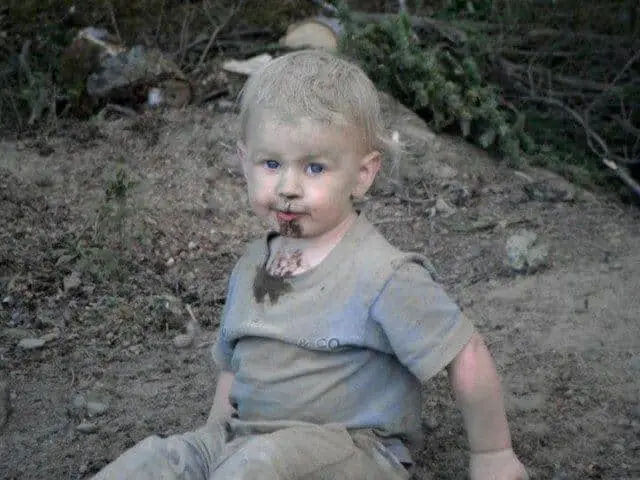I’ve had more discussions about poop since I became a mom than a bus full of grade-schoolers could giggle at in a year. It’s surprising how unchanged what goes in comes out when it comes to infants, and how often what goes in that isn’t food. Between 80 to 90 percent of the time, when a baby eats a non-food item, it comes out the other end just as it went in, but a bit smellier. You have to wonder if this will be the time that whatever it was won’t be an odd surprise in a diaper shortly after. None of the above is going to change the fact that babies put everything in their mouths, and swallow it if that fits their fancy at the time.
What should I do if my baby ate a foreign object or other non-food stuff?
Dirt, sand, rocks, leaves, grass, and other nature stuffs:
One of my sons was a nature-eater. He seemed to actually like eating dirt and sand. While all of the above makes for some seriously interesting diapers, it’s usually not cause for concern and will just pass right through. In the case of rocks, keep an eye out for signs of a problem (see below) as they can be sharp. The main risk of your baby eating outdoor substances is you don’t know what else was there. Your grandmother is right, dirt can’t hurt, but what could be in dirt can. Dirt, sand, and other ground cover can contain feces, chemicals, and parasites. If your baby does eat a bit of nature, watch out for signs of sickness including diarrhea, unexplained itching, or otherwise unusual behavior. The same applies if your baby hits up the litter box or finds a dog mess in the grass. As gross as it is to find your baby ate poop, chances are your baby will be fine. It’s just best to keep an eye out, and take your baby to a pediatrician if you see any signs of sickness.
Crayons, Playdough, Legos, and other small play stuffs:
As long as the object is small, and has no sharp edges, the chances it will come out the far end are high. In the case of things like art supplies, refer to the label for toxicity. In the event there is no warning — for example my baby once licked a wet-paint brush that had interior bedroom paint on it — call poison control for advice.
Pennies, batteries, pins, earrings and other sharp or metal objects:
There are a few objects that do require immediate medical care.
Pennies dated after 1982: After 1982 the material used to make pennies changed due to rising copper costs. Zinc, one of the cheaper metal additions, is highly corrosive. If a penny fails to pass, the damage that can be done while you wait to see can be more severe.
Batteries: I know. How could a baby swallow a battery? Smaller batteries such as those for watches may not be what come to mind when you think of a battery, but they do exist. If you’ve ever touched a battery to your tongue and felt the zap, you can understand why batteries require medical attention.
Anything sharp: Sharp objects run a much higher risk of becoming stuck or perforating your baby’s digestive track.
Unknown foreign object: If you’re not sure what it was you saw in your baby’s mouth for a mere instant before it went down the hatch, you should also seek medical attention in the interest of just-in-case.
What to watch out for after your baby has swallowed an object:
In the event you decide not to seek medical attention after finding your baby ate something weird, you should watch for the following:
-Vomiting
-Excessive uncharacteristic drool
-Refusal to eat
-Coughing and wheezing
-Signs of pain
-Blood in diapers.
You should also be on the look-out for the item. If it doesn’t emerge in your baby’s diaper within a few days, you need to see your pediatrician.
What to do if your baby is choking on an object:
If your baby swallows an object and it doesn’t make it all the way down, you’ll need to take immediate action to clear the airway. If your baby is actively coughing, simply tip them forward and let them continue to cough.
If coughing does not free the item, you can first try the infant Heimlich. Place your baby face down, with his or her body supported by your forearm. Apply 5-6 firm thumps to your baby’s back just between the shoulder blades. Use the heel of your hand. If your baby is able to breathe, and the first attempt fails, it’s OK to repeat.
If your baby can’t breathe, or it’s clear this method is not working, gently flip your baby on to his/her back. Trace an imaginary line between your baby’s nipples. Place two fingers, one finger width below the line, then give 4-5 short thrusts pushing no deeper than an inch. You may alternate between techniques.
If at any time your baby begins to change colors from lack of air, have someone call 911 immediately; if you are the only person present, first give two breathes, then call 911 and continue.
To give breaths, lay your baby on his/her back, then tilt her/his head back slightly and cover their nose and mouth with your mouth. Breathe into your baby until you see your baby’s chest rise, then allow the air out, and repeat. If your baby’s chest doesn’t rise with your breaths, try repositioning the head tilt. If you’re still not seeing signs air is getting in, perform 30 chest compressions.
While my babies are now toddlers and I’ve never had to perform CPR, or even give the infant Heimlich, it is recommended you take classes to be well versed in both.
What’s the weirdest thing your baby has ever eaten?

